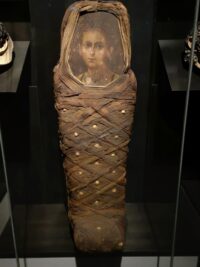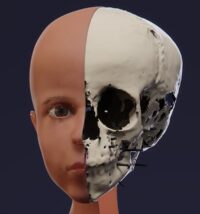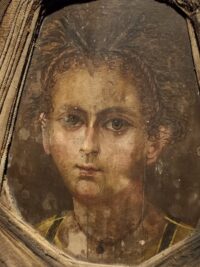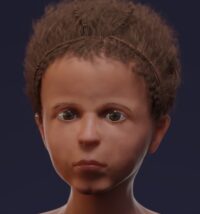 A facial reconstruction of the mummy of a young child has revealed that his mummy portrait was remarkably realistic. Mummy portraits, a funerary tradition specific to Greco-Roman Egypt, were painted on wood boards and placed over the face of a linen-wrapped mummified body. There are about 1,000 known mummy portraits extant today, most of them discovered in the Fayoum area of Lower Egypt, but less than 100 of them are still attached to their original mummy.
A facial reconstruction of the mummy of a young child has revealed that his mummy portrait was remarkably realistic. Mummy portraits, a funerary tradition specific to Greco-Roman Egypt, were painted on wood boards and placed over the face of a linen-wrapped mummified body. There are about 1,000 known mummy portraits extant today, most of them discovered in the Fayoum area of Lower Egypt, but less than 100 of them are still attached to their original mummy.
Because of the realism and individualized features of the portraits, they are believed to be representations of the faces of the deceased, but few studies have been done on matched portraits and mummies, and in the ones that have created facial reconstructions from the embalmed remains, the results have varied. Most of the portraits were (pardon the pun) dead ringers for the mummy; a few seemingly bore no resemblance.
The most recent study is the first to compare a child mummy to its portrait. The subject in question has been part of the collection of the Staatliches Museum Ägyptischer Kunst (SMAEK) München since 1912 when it was donated to the Royal Bavarian Collection of Antiquities by renown archaeologist Sir Flinders Petrie. Petrie had unearthed it himself the year before during an excavation at Hawara, the entrance point to the Fayoum oasis.
The mummy is 30 inches long and artfully wrapped with criss-crossed linen bandages adorned with gilded plaster buttons. The portrait depicts a young child about three or four years old with large brown eyes and brown hair. X-rays identified the child as male. The hair is curly with two braids woven from center to ears just above the hairline.
 Researchers CT-scanned the mummy and reconstructed the skull from the scans. They then used the scan data and 3D software to reconstruct the eyes, skin, nose and soft tissue. The reconstruction artist was not allowed to see the portrait or even get anything information about it so as not to influence the rendering.
Researchers CT-scanned the mummy and reconstructed the skull from the scans. They then used the scan data and 3D software to reconstruct the eyes, skin, nose and soft tissue. The reconstruction artist was not allowed to see the portrait or even get anything information about it so as not to influence the rendering.
The facial reconstruction shows a child with typical infantile facial features very similar to those of the portrait. On the biometrical level, the proportions between the dimension of the forehead to the eye line, the distance to the lower nasal aperture and the mouth opening were exactly the same between portrait and reconstruction. However, differences existed between the width of the nasal bridge and the size of the mouth opening with both being more slender and “narrow” in the portrait than the virtual reconstruction. […]
There are, however, certain distinct differences between portrait and face: on a subjective level, the portrait appears slightly “older”; on a biometric level, the width of the nose and the mouth are smaller in the portrait than in the face, which might explain the perceived difference in age.
Flinders Petrie thought the portraits were made ante-mortem because they had all been cut down to fit the mummy and because he found one that hadn’t yet been attached to a mummy. Some current scholars have also proposed that the portraits were made from life. While that makes sense for adults, it seems unlikely that so young a child would have a death portrait ready to go just in case. There is evidence of pneumonia in his lungs, so its seems he was stricken by a sudden fatal illness.
The study has been published in the journal PLUS One. It’s a good read and has excellent supplementary materials, including four videos of different stages of the reconstruction process.

